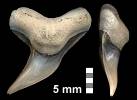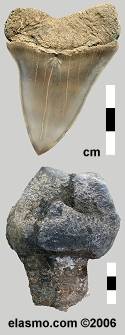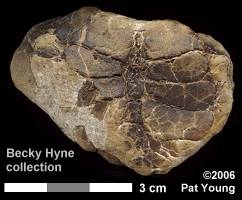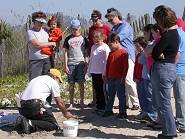| |
| ... |
|
|
|
|
|
| |
| December 2, 2006 |
|
Weekend 10 -- Season comes to an end
Pat Young reports: A morning temp of 48 quickly turned into a balmy 62-degrees making for a great final collecting day of the fall season. Using a new (less muddy) entrance permitted access to some tailings that hadn't been collected since the fall-2004 season (older NCPC area). The hills were well weathered, vegetation dried and most fossils in surprisingly good condition (considering the amount of time they had likely been exposed).
The largest meg of the day (4") was a re-worked tooth found by newcomer Rise Talley. JoCarol Titmas followed with a 3-1/2" upper lateral (image) and Eric Sadorf with a 3-1/4 " posterior. George Oliver got a nice 2-3/4 inch Pungo UA1 that had weathered out of limestone and a smaller lateral. Every collector had a few nice large examples of Cosmopolitodus hastalis (narrow forms outnumbered the broad variety) and Galeocerdo cuviers; a Carcharodon carcharias was found by Eric Sadorf. The usual assortment of other shark teeth was very well represented.
Marine mammal fossils included good quality whale teeth, a few vertebrae, nice periotics and two Squalodon teeth (Fred Mazza and George Oliver). Reggie Titmas and Lydia Wilcox collected shark bitten cetacean bones. Dave Sanderson and I each found ray dermal scutes (image).The dried reclamation can be a treasure trove of Pleistocene fossils; George Powell found a small crab carapace and Lydia Wilcox gathered Pleistocene shells for her school. It was a great final day of the fall season.

I'm sure we would all like to thank those employees of PCS Phosphate (especially Curtis Ormond, Sr.) who made every effort to insure a safe and successful fall season.
|
| November 30, 2006 |
|
Tooth Donations Needed
New Jersey Paleo member Tom Caggiano is in the process of building a new exhibit for the Aurora Fossil Museum entitled "Why are there so many Shark teeth?" Museum Curator Rich Olsen is planning to use this exhibit in the Shark Dentition room of the museum. The exhibit will be designed for the general public and will discuss the shark tooth replacement system.
 As part of the exhibit they would like to show the lifetime tooth output from one shark. While it can only be a guess, they estimate it likely falls between five and ten thousand. Tom is planning on using teeth from Physogaleus (formerly Galeocerdo) contortus, a common species from the Miocene of Lee Creek and is soliciting donated specimens. Donations can be left with Pat Young at the bus on collecting days, dropped off at the museum, or mailed to Tom (145 Hayrick Lane, Commack, NY 11725).
As part of the exhibit they would like to show the lifetime tooth output from one shark. While it can only be a guess, they estimate it likely falls between five and ten thousand. Tom is planning on using teeth from Physogaleus (formerly Galeocerdo) contortus, a common species from the Miocene of Lee Creek and is soliciting donated specimens. Donations can be left with Pat Young at the bus on collecting days, dropped off at the museum, or mailed to Tom (145 Hayrick Lane, Commack, NY 11725).
|
| November 25, 2006 |
|
Weekend 9 -- Collecting Cancelled
Because of the huge rains of the week (nearly 6 inches), it was impossible to safely access the collecting area and this weekend was cancelled.
|
| November 18, 2006 |
|
Weekend 8 -- Cold and cooler
Pat Young reports: Cold biting wind and extremely muddy access to the collecting area did nothing to dampen the rollicking spirits of today's group. The hot topic of the morning was if the previous week's two inches of rain had covered or uncovered the fossils. Whether by choice or circumstance, most collectors came back to the bus with Pungo fossils. The largest shark tooth found today was a 2-1/2" lower Cosmopolitodus hastalis (narrrow-form) collected by Bill King. Other hastalis, both broad and narrow, and only slightly smaller were found by Sandy Shelton, Doug Slezak, Jim Slingo, and Becky Hyne. Becky had spent the day searching only for Bramble shark teeth, proving if you look for the smallest teeth, you'll find the larger ones. The top meg of the day was a great lower C. chubutensis (2-1/4") found by Carmen Medina. Doug Slezak got a 3-1/2 inch one missing a root ear and Ron Edwards & Becky brought out nice posteriors. Notorynchus lowers were shown by Bill King, Judy King, Jim White (2) and Sandy Shelton. Jay Goldberg reported the only Carcharodon carcharias - a 1-3/4" pretty black specimen. Whale vertebrae were heavily collected again this week. Brenda Albright finally gave in to mud-encrusted boots and allowed husband Andy to help her with her 5-gallon bucketful plus one in each hand. Other interesting fossils seen were: crocodile tooth (Ron Edwards), Squalodon incisor (Sharron Edwards), whale bulla (Sandy Shelton) and 2 turtle leg bones (Jim White).
|
| November 11, 2006 |
|
Weekend 7 -- Warmer but Cooler
Pat Young reports: The enthusiasm of Saturday's group was hard to contain; several persons were new to Lee Creek collecting and anxious to sample the fossil bounty. The weather was breezy and unseasonably warm, ending with a high temperature of 78 degrees. If collecting results are any indication, little time was wasted on socializing.
 Complete Carcharocles megalodon/chubutensis teeth were found by Ken Young (3-3/4"), Gregg Walden (3-1/2"), Tedo Kordela (2-1/2" Pungo lateral); several damaged ones were also seen. Jason Osborne got the largest Cosmopolitodus hastalis broad-forms (two at 2-1/2 and a 2-1/4 inch lateral, see image), but lots of smaller ones were collected. Bea Hall found the season's first Parotodus benedeni; unfortunately, it was missing a large portion of the root. Those collecting the Yorktown reported huge finds of Galeocerdo cuvier - one collector had 17. Pungo collectors showed many nice narrow-form hastalis and an abundance of "other" teeth; Ted Kordela found a Squalodon cf atlanticus premolar. The James City sediments produced sand dollars for Gail Leget, Gregg Walden and Becky Hyne (she also got a large Diodora pamlicoensis - keyhole limpet), and for Ken Young, a Carcharodon carcharias upper A1. Several nice whale bullas, teeth and buckets of vertebrae were picked up. Tom Walden and Cherie & Chad Nutwell got a good start on building their own fossil whales but labored over getting the buckets back to the bus. Jason Osborne started smaller with an associated set of four phalanges and a humerus.
Complete Carcharocles megalodon/chubutensis teeth were found by Ken Young (3-3/4"), Gregg Walden (3-1/2"), Tedo Kordela (2-1/2" Pungo lateral); several damaged ones were also seen. Jason Osborne got the largest Cosmopolitodus hastalis broad-forms (two at 2-1/2 and a 2-1/4 inch lateral, see image), but lots of smaller ones were collected. Bea Hall found the season's first Parotodus benedeni; unfortunately, it was missing a large portion of the root. Those collecting the Yorktown reported huge finds of Galeocerdo cuvier - one collector had 17. Pungo collectors showed many nice narrow-form hastalis and an abundance of "other" teeth; Ted Kordela found a Squalodon cf atlanticus premolar. The James City sediments produced sand dollars for Gail Leget, Gregg Walden and Becky Hyne (she also got a large Diodora pamlicoensis - keyhole limpet), and for Ken Young, a Carcharodon carcharias upper A1. Several nice whale bullas, teeth and buckets of vertebrae were picked up. Tom Walden and Cherie & Chad Nutwell got a good start on building their own fossil whales but labored over getting the buckets back to the bus. Jason Osborne started smaller with an associated set of four phalanges and a humerus.
Since most of the upper James City beds are used for reclamation projects, they are rarely available for collecting and the value of dried reclamation is beginning to be appreciated. In addition to having nice shells and an occasional crab (Gregg Walden got a 3-incher), it produced a partial mastodon (Mammut americanum) molar (image) for Judy Stiles and a partial tusk & toe bone for BJ Blake.
We are happy to have access to this collecting area but caution that it continues to remain available only on a weekly basis.
|
| November 4, 2006 |
|
Weekend 6 -- Cold but Hot
Pat Young reports: Despite a heavy morning frost (temp 34 deg.) accompanied by extremely windy conditions, the fossil gods smiled generously on today's collectors. Carcharocles megalodon teeth, elusive last week, surfaced in relative abundance. The largest, a 4-1/4 inch lower anterior, was found by Tim Icenhower, who also added a 2" lateral. Matt Wojtko got a beautiful 4-inch, gold-colored upper anterior C. chubutensis (in Pungo limestone matrix) and a 3" lateral. Darren Cranfill, a first time Aurora collector, took his lunch break in patch of Yorktown and found three megs within 15 feet of each other: a 3" lower anterior and 3-1/2" & 2-3/4" upper laterals. Other megs of note included those by Steve Schaible (4" & 3-1/2"), Gina Moore (3"), Gene Yates (2-1/4" posterior) and Jim White (2"). Most megs were found on the two hills nearest and farthest left of the bus. Three Carcharodon carcharias were found - two by Gregg Walden and one Al Klatt. Clay Keiffer got a nice Notorynchus symphyseal with gray crown and black root.
Being unable to find a good otolith patch, Betsy Hallman and Barbara Shea happily settled on a lower Yorktown hill and assembled a large collection of black fish fossils. Buckets were filled with other fossils: large whale vertebrae (Steve Schaible & Richard Zeman), whale bulla (GeneYates & Mary Frances Comer) and marlin predentary (Wes Schaible).
 The James City fossils are not overlooked by even the most hardened (usually male) tooth collectors. Many good quality shells were collected, including a 4" Conus adversarius by Al Klatt. Three crabs appearing to be Callinectes sapidus, the modern Blue crab, were found - two by Becky Hyne and one by this reporter. The James City fossils are not overlooked by even the most hardened (usually male) tooth collectors. Many good quality shells were collected, including a 4" Conus adversarius by Al Klatt. Three crabs appearing to be Callinectes sapidus, the modern Blue crab, were found - two by Becky Hyne and one by this reporter.
The most admired fossil of the day had to be Gina Moore's outstanding plate of ray dermal denticles; her jet black specimen measured three inches diameter and contained 4 crowns.
|
| October 28, 2006 |
|
Weekend 5 -- Success Continues
Pat Young reports: This weekend’s storm cleared earlier than forecasted allowing Saturday collectors to gather under cloudy but rainless skies. The news of last week’s collecting had spread rapidly; the morning’s hot topic was whether we’d be collecting the same area. A PCS representative affirmed that hope and we wasted little time boarding the bus.
Although megs didnt show up in last week's quantities, most other shark teeth were plentiful and of high quality. The largest megs were reported by Uwe Heine (3-inch upper lateral) and Lee Creek newcomer Kyle Grimsley (2-¼ inch lower anterior). Broad-form Cosmopolitodus hastalis were collected by most visitors with specimens of 2+ inches found by Ron Harding, John Nash and Linda Wooten (2-¾ inch lower anterior). Pungo areas produced numerous narrow-form hastalis in pristine condition. Notorynchus lowers, large G. cuvier and Hemispristis were in nearly every visitor's bag. Several collectors showed nice stingray dermal scutes; Ron Edwards’ 3-inch long specimen contained multiple crowns, BJ Blake's was butterfly shaped and others were of the more common design. Small contortus and carcharhinind teeth were found with little effort. Cetacean vertebrae, bullas, periotic bones and teeth are still available -- Gary Grimsley's whale tooth was 5+ inches. So far the Pungo River hasn't produced a bramble tooth, but given the availability of large teeth and good vertebrate material, the "Pungo crawl" is not yet heavily practiced.
The collecting area includes several nice upper James City Fm exposures (invertebrate deposits); sand dollars were collected by Linda Wooten, George Powell, BJ Blake, Uwe Heine, Ron Harding and John Nash. Gastropods in outstanding condition are abundant for fossil shell lovers. Although he’s normally thought of as a tooth hunter, Gary Grimsley proudly showed off a large Top snail shell (Calliostoma philanthropum pontoni).
This area is large and well-weathered; if it continues to be available, it should provide bountifully through the remainder of the fall season.
 Editor's note: During this season's first weekend, Curtis Ormond made an announcement about the South Carolina Fossil & Shell Fair at Ocean Lakes this weekend. Since Howie Cohn and I were passing through the area on Saturday we used the opportunity to drop by the function. The Aurora festival may be larger, but can't compare with this spectacular location on Atlantic beach front. This beach also serves as the location for the fair's most popular attraction for younger attendees -- the mock dig site. Similar to Aurora, PCS presented a large display and the Smithsonian provided technical expertise. Editor's note: During this season's first weekend, Curtis Ormond made an announcement about the South Carolina Fossil & Shell Fair at Ocean Lakes this weekend. Since Howie Cohn and I were passing through the area on Saturday we used the opportunity to drop by the function. The Aurora festival may be larger, but can't compare with this spectacular location on Atlantic beach front. This beach also serves as the location for the fair's most popular attraction for younger attendees -- the mock dig site. Similar to Aurora, PCS presented a large display and the Smithsonian provided technical expertise.
|
| October 21, 2006 |
|
Weekend 4 -- Better tailings
Pat Young reports: A crisp fall morning greeted this season's fourth group of fossil collectors at Aurora. Although parking lot chatter seemed for a while to take top priority, Becky finally managed to get us boarded. Once in the pit-car area, we discovered that mining activities had moved during the preceding week and our pile was being replenished in preparation for processing at the plant. Some quick negotiations between Becky and PCS personnel allowed us to check out a previously unavailable area. The area was determined to be safe and we began the nearly one mile hike to the "Hills of Heaven", as one collector later called them. These previously untapped areas could only be called great!! All three formations were present and abundantly produced good quality fossils.
Nearly every collector left with more than one meg or chubbie. The largest tooth was a nice 4-1/2 inch lower C. megalodon reported by Dave Grabda. Karissa Hendershot brought out the next largest, a 4-1/4 inch upper lateral. Broad and narrow-form Cosmopolitodus hastalis teeth in the 2-1/4 inch range were not uncommon. Maria Gerber, new to Lee Creek collecting, managed to find her first Notorynchus tooth. Aduncus teeth had acquired that beautiful reddish color that comes from long exposure to the sun; other teeth had bleached white roots and golden yellow crowns. The James City produced equally outstanding fossils of some shells not often seen at Aurora these days. Daryl Serafin got two valves of Brachiodontes exustus (mussel) and Sohpie Homesy a Sinum perspectivum (baby's ear). One had to walk carefully to avoid crushing Crucibulum & Docina shells. Other finds included a large marlin beak (Karissa), marlin vertebra & tail (Bob Asreen), complete 2-1/2 inch stingray spine (John Adams), ray toothplate (Donald Muller) and an outstanding anterior Squalodon tooth (Becky Hyne).
We are very grateful to PCS for taking this extra step to insure fossil visitors had a good time today. We'd like to report that this area would be available for the rest of the season; unfortunately, equipment is in place to begin the process of reclamation and no guarantees are possible. Collecting active mines has the advantage of producing constantly renewable opportunities; but occasionally we are required to step aside to make those opportunities possible.
|
| October 14, 2006 |
|
Weekend 3 -- Too little rain
A day made for collecting fossils -- mid 40's morning with midday high in mid 60's.
Fortunate were those today who visit Lee Creek exclusively in search of carcharhinid teeth; others weren't as lucky. A brief rain shower earlier in the week had not been sufficient to provide a repeat performance of last week's collecting. After a quick but thorough surface search, most collectors got down to serious business with a rake. A few C. chubutensis were found but all had suffered some damage. Jeff Sparks found a nice hastalis upper anterior and Mike Keklak a lateral in matrix. Contortus and aduncus teeth were even scarce and Hemipristis seemed non-existent. Mel Gulotta found a large crocodile tooth, Jeff Sparks a Squalodon incisor with dinged crown, Roxada Story a piece of fossil wood and Candace a tooth (Lagodon rhomboides) tooth. Bob Henderson, an accomplished gem cutter, carried home a piece of coral to cut and study. Three porpoise periotics and a partial jaw bone were also found. Quite a few bucketsful of dirt were carried home for more careful screening.
It is apparent that rain and lots of it is the key to successful fossil collecting this pile. On a more upbeat note, the hillside chatter with friends we haven't seen for several months makes the lack of fossils more bearable.
|
| October 7, 2006 |
|
Weekend 2 -- Add a little rain
Pat Young reports: This weekend, Friends of the Museum were greeted with the first cool morning of the fall season (54 degrees). Heavy rain on Friday peaked hopes that this weekend's pit-car collecting would be more prolific. Those with foresight brought buckets to collect tailings for home search.
Becky deftly guided the bus down the slippery ramp for the cheerful group. Collectors wasted no time in plodding through mud to get to a choice spot. Almost immediately, Eric Sadorf found an unusual white-crowned Carcharocles chubutensis tooth (with a dark root) on top of the hill. Surface collecting began in earnest with a few other nice chubbies being found. Lee Cone got several nice Cosmopolitodus hastalis and Mary Lightfoot two large Carcharoides catticus laterals; large sand tiger shark teeth were also collected. After making fast work of the easy pickings, intense collecting began in earnest. The remaining teeth were mostly small Carcharhinus, Hemipristis and contortus. Tom Caggiano found a very nice tiny Squalodon molar. Matt Howard made use of a small rain puddle to sift for micro fossils. Crab-burrowed rocks produced a small whale tooth, two associated shark vertebrae and a cetacean vertebra. These burrowed rocks make nice garden features and a couple of people took advantage of their availability.
If the rains continue to help us out, collecting should get better as the season goes on — that's a different twist than collecting the pit itself.
|
| October 1, 2006 |
|
Weekend 1 -- Pit-car tailings, the need for weathering
Despite PCS's efforts to provide a collecting opportunity and Mother Nature's spectacular day to accompany it, un-weathered tailings are impossible to successfully collect. This was again proven on Saturday when twenty Friends assembled from around the country for kick-off weekend.
First visited during the Spring 2004 season, these pit-car tailings are strategically positioned above the pit adjacent the gigantic draglines overlooking the mine -- they are highly fossiliferous. Unlike the pit's tailings which require many months of rains to expose fossils in quantity, the pit-car material requires significantly less. However, many weeks are not particularly helpful when the draglines are moving at a pace which exceeds this shortened cycle; this unfortunate reality faced collectors.
As a group, these visitors were an experienced group accustomed to employing various techniques with dogged determination. When a majority was prepared to return to the parking lot before 11 am, it spoke volumes for the extent of the challenge. An unscheduled 'first bus' departed at noon with 85% of the Friends. As might be expected, none left empty-handed; however, most of the take occurred in the first hour. The few megs were generally damaged and most hastalis small.
From a personal perspective, I can only evaluate the experience from a cost-benefit basis. I enjoyed the day & social interaction and appreciated PCS's attempt to provide collecting opportunities during the reclamations process; but the fossil-take was minimal and balanced poorly with 1100 mile / three-day investment. Because I am unable to foresee a rapid turn-around in the collecting conditions, I can only suggest that others consider these observations.
As an advisory note, the road north from Aurora has been reconfigured. It will fork north of town (bear left) taking you through the mine, then leading you back to the 'old' parking lot.
|
| September 2, 2006 |
|
Ernesto Preps Area
 With Ernesto thoroughly drenching the mine, it's hard to avoid thinking of well-washed Yorktown tailings - maybe even pedestaled megs begging attention. Alas, this cleansing will have much less long-term benefit for the pit-car area, but should still be beneficial.
With Ernesto thoroughly drenching the mine, it's hard to avoid thinking of well-washed Yorktown tailings - maybe even pedestaled megs begging attention. Alas, this cleansing will have much less long-term benefit for the pit-car area, but should still be beneficial.
Speaking of the season, I was talking with Paul Murdoch and he indicated the Friends had been slow to respond to their exclusive invite; Fall slots were still available. If you're a Friends member, be sure to contact them.
|
| August 18, 2006 |
|
Fall Season Announced
As mid-August approached without final word on a Fall season, it became apparent that the Spring's relentless reclamation was not going to be parted by some Moses-like intervention; finally, an email arrived.
Pat Young reports: For many years Lee Creek fossil collectors have aspired to the day when the Aurora mining process would begin an advance toward the Pamlico River and more Yorktown deposits. That day has now come. The new highway, making a cut through the mine, is traveled daily. Some former collecting areas are now nicely landscaped ponds teeming with shorebirds and turtles. Sitting high above the mine pit, this new road allows spectacular views of the draglines and last season's collecting area. Unfortunately, this eastward migration comes with a price -- no mined area is available for collecting this fall season. Special negotiations with Mine personnel have allowed for use of the pit-car areas for collecting purposes. These small piles of leftover mining soil on the dragline bench contain lower Pungo River fossils. Such fossils are typically found in the oversized phosphate material commonly known as "reject". As former owners and generous corporate sponsors of the Aurora Fossil Museum, PCS has decided to donate this season's very limited collecting slots to the Friends of the Museum.
Curtis Ormond has announced, "Due to current mining conditions, we will be able to hold only a very limited fall collecting season. Fossil collecting will be allowed in the areas left by the pit-car operations. We feel that the small area set aside for collecting would be best used by allowing only 20 people per Saturday. We have made an agreement with the Aurora Fossil Museum and their Special Friends of the Museum organization to allow them full use of these slots. We expect this to be a temporary situation and hope to resume full collecting opportunities in the spring."
Editor's note: My understanding is that the season will commence September 30 and run through December 2 -- Saturday's only. There is a mixed blessing to these 'pit-car' tailings in that it is one of the few opportunities to collect larger material from Pungo units 1-3 (Lower Miocene), and a greater likelihood of finding amber or teeth from C. catticus and I. retroflexus. In the past, these small areas have been highly stressed by collecting pressure and the decision to limit access to twenty collectors once a week a very good idea.
|
|
|